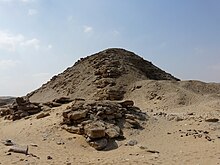
Back هرم ني أوسر رع Arabic هرم نى اوسر رع ARZ Piràmide de Niuserre Catalan Niuserre-Pyramide German Pirámide de Nyuserra Spanish هرم نیوسررع Persian Pyramide de Niouserrê French Ниусерева пирамида Macedonian Piramide van Nioeserre Dutch Piramida Niuserre Polish
| Pyramid of Nyuserre | |
|---|---|
 | |
| Nyuserre Ini | |
| Coordinates | 29°53′44″N 31°12′13″E / 29.89556°N 31.20361°E |
| Ancient name | |
| Constructed | Fifth Dynasty |
| Type | Smooth-sided (now ruined) |
| Material | Limestone |
| Height | 51.68 m (169.6 ft; 98.63 cu)[5] |
| Base | 78.9 m (259 ft; 150.6 cu)[5] |
| Volume | 112,632 m3 (147,317 cu yd)[6] |
| Slope | 51° 50' 35''[5] |
The pyramid of Nyuserre (Egyptian: Mn-swt Nỉ-wsr-rꜥ, meaning "Enduring are the places of Nyuserre") is a mid-25th-century BC pyramid complex built for the Egyptian pharaoh Nyuserre Ini of the Fifth Dynasty.[7][a] During his reign, Nyuserre had the unfinished monuments of his father, Neferirkare Kakai, mother, Khentkaus II, and brother, Neferefre, completed, before commencing work on his personal pyramid complex. He chose a site in the Abusir necropolis between the complexes of Neferirkare and Sahure, which, restrictive in area and terrain, economized the costs of labour and material. Nyuserre was the last king to be entombed in the necropolis; his successors chose to be buried elsewhere. His monument encompasses a main pyramid, a mortuary temple, a valley temple on Abusir Lake, a causeway originally intended for Neferirkare's monument, and a cult pyramid.
The main pyramid had a stepped core built from rough-cut limestone and encased in fine Tura limestone. The casing was stripped down by stone thieves, leaving the core exposed to the elements and further human activity, which have reduced the once nearly 52 m (171 ft; 99 cu) tall pyramid to a mound of ruins, with a substructure that is dangerous to enter due to the risk of cave-ins. Adjoining the pyramid's east face is the mortuary temple with its unusual configuration and features. Replacing the usual T-shape plan, the mortuary temple has an L-shape; an alteration required due to the presence of mastabas to the east. It debuted the antichambre carrée, a square room with a single column, which became a standard feature of later monuments. It also contains an unexplained square platform which has led archaeologists to suggest that there may be a nearby obelisk pyramidion. This is unusual as obelisks were central features of Egyptian sun temples, but not of pyramid complexes. Finally, the north-east and south-east corners of the site have two structures which appear to have been pylon prototypes. These became staple features of temples and palaces. In the south-east corner of the complex, a separate enclosure hosts the cult pyramid – a small pyramid whose purpose remains unclear. A long causeway binds the mortuary and valley temples. These two were under construction for Neferirkare's monument, but were repurposed for that of Nyuserre. The causeway, which had been more than half completed when Neferirkare died, thus has a bend where it changes direction from Neferirkare's mortuary temple towards Nyuserre's.
Two other pyramid complexes have been found in the area. Known as Lepsius XXIV and Lepsius XXV, they may have belonged to the consorts of Nyuserre, particularly Queen Reputnub, or of Neferefre. Further north-west of the complex are mastabas built for the pharaoh's children. The tombs of the priests and officials associated with the king's funerary cult are located in the vicinity as well. Whereas the funerary cults of other kings died out in the First Intermediate Period, Nyuserre's may have survived this transitional period and into the Middle Kingdom, although this remains a contentious issue among Egyptologists.
- ^ Borchardt 1907, p. 2.
- ^ Verner 1994, p. 80.
- ^ a b Altenmüller 2001, p. 599.
- ^ Grimal 1992, p. 116.
- ^ a b c Lehner 2008, p. 149.
- ^ Bárta 2005, p. 180.
- ^ a b Verner 2001c, p. 589.
- ^ Clayton 1994, p. 30.
- ^ Shaw 2003, p. 482.
- ^ Málek 2003, p. 100.
- ^ Allen et al. 1999, p. xx.
- ^ Lehner 2008, p. 8.
- ^ Dodson & Hilton 2004, p. 288.
Cite error: There are <ref group=lower-alpha> tags or {{efn}} templates on this page, but the references will not show without a {{reflist|group=lower-alpha}} template or {{notelist}} template (see the help page).
